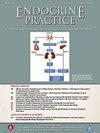Bone Mineral Density Improvement After Resolution of Endogenous Cushing Syndrome: A Systematic Review and Meta-Analysis
IF 3.7
3区 医学
Q2 ENDOCRINOLOGY & METABOLISM
引用次数: 0
Abstract
Objective
We aimed to identify all evidence to evaluate bone mineral density (BMD) improvement after resolution of endogenous Cushing syndrome (eCS).
Methods
Potentially eligible studies were identified from the EMBASE and PubMed databases from inception to February 2024, utilizing a search strategy incorporating terms related to "Bone mineral density" and "Cushing syndrome". Eligible studies must include patients diagnosed with eCS. These studies must present lumbar spine (LS) or femoral neck (FN) BMD measurements before and after resolution of eCS. Point estimates with standard errors were extracted from each study and combined using the generic inverse variance method. Meta-regression analysis was utilized to explore factors influencing BMD improvement.
Results
After systematic review, 5085 records were identified. After systematic review, 12 studies (302 patients, mean age of 13-44 years, % female patients 57%-92%, follow-up time 16-60 months) were eligible. The meta-analysis demonstrated that resolution of eCS resulted in improvements in LS BMD (pooled mean difference T-score: +0.86, I2 80.4%; 95%CI 0.51-1.21; Z-score: +0.86, 95%CI 0.57-1.16, I2 75.9%) and FN BMD (pooled mean difference: T-score: +0.38, 95%CI 0.26-0.51, I2 0.0%; Z-score: +0.44, 95%CI 0.31-0.57, I2 20.3%). The meta-regression analysis identified factors potentially influencing LS BMD increases, including longer follow-up time, higher %female patients and lower mean baseline 24-hour UFC, while none of these factors were significantly associated with FN BMD changes.
Conclusion
Our study presents the degree and influencing factors of BMD improvement following eCS resolution. These findings offer guidance for management of eCS-associated osteoporosis.
内源性库欣综合征解决后骨密度改善:系统回顾和荟萃分析。
目的我们旨在找出所有证据,以评估内源性库欣综合征(eCS)缓解后骨矿物质密度(BMD)的改善情况:利用包含 "骨矿物质密度 "和 "库欣综合征 "相关术语的搜索策略,从 EMBASE 和 PubMed 数据库中找出从开始到 2024 年 2 月可能符合条件的研究。符合条件的研究必须包括确诊为 eCS 的患者。这些研究必须提供 eCS 缓解前后的腰椎 (LS) 或股骨颈 (FN) BMD 测量结果。从每项研究中提取带有标准误差的点估计值,并使用通用逆方差法进行合并。利用元回归分析探讨影响 BMD 改善的因素:结果:经过系统回顾,共发现 5,085 条记录。经过系统回顾,12 项研究(302 名患者,平均年龄为 13 - 44 岁,女性患者比例为 57 - 92%,随访时间为 16 - 60 个月)符合条件。荟萃分析表明,eCS 的缓解可改善 LS BMD(汇总 MD T-score:+0.86,I2 80):+0.86, I2 80.4 %; 95%CI 0.51 - 1.21; Z-score:+0.86,95%CI 0.57 - 1.16,I2 75.9%)和 FN BMD(汇总 MD:T-score:+0.38,95%CI 0.26 - 0.51,I2 0.0%;Z-score:+0.44,95%CI 0.31 - 0.57,I2 20.3%)。元回归分析确定了可能影响 LS BMD 增加的因素,包括随访时间较长、女性患者比例较高和 24 小时 UFC 平均值较低,而这些因素均与 FN BMD 变化无显著关联:我们的研究介绍了 eCS 缓解后 BMD 改善的程度和影响因素。这些发现为 eCS 相关骨质疏松症的治疗提供了指导。
本文章由计算机程序翻译,如有差异,请以英文原文为准。
求助全文
约1分钟内获得全文
求助全文
来源期刊

Endocrine Practice
ENDOCRINOLOGY & METABOLISM-
CiteScore
7.60
自引率
2.40%
发文量
546
审稿时长
41 days
期刊介绍:
Endocrine Practice (ISSN: 1530-891X), a peer-reviewed journal published twelve times a year, is the official journal of the American Association of Clinical Endocrinologists (AACE). The primary mission of Endocrine Practice is to enhance the health care of patients with endocrine diseases through continuing education of practicing endocrinologists.
 求助内容:
求助内容: 应助结果提醒方式:
应助结果提醒方式:


